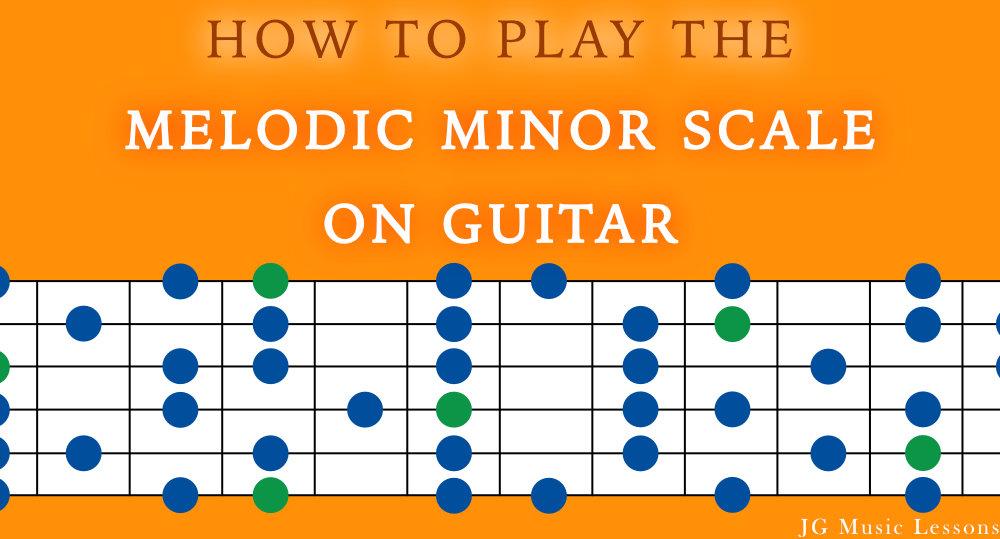The melodic minor scale is a unique and cool sounding scale which is commonly used in jazz improvisation. If you already know the Major and natural minor scale, learning the melodic minor scale is an awesome scale to have in your tool belt.
In this lesson we’ll cover:
- The formula to learn the melodic minor scale in all keys
- Melodic minor scale application examples
- The 5 melodic minor scale shapes to learn on guitar.
- Scale patterns you can use for application.
Let’s get started.
What is the melodic minor scale?
The melodic minor scale is built on the scale degrees 1, 2, b3, 4, 5, 6, and 7. For example, a C melodic minor scale has the notes C, D, Eb, F, G, A, and B.
The melodic minor scale is different from the natural minor scale which has the scale degrees 1, 2, b3, 4, 5, b6, and b7. For example, the C natural minor scale has the notes C, D, Eb, F, G, Ab, and Bb.
An easy way to think of the melodic minor scale is to simply flatten the 3rd of a Major scale. Other than the 3rd degree of the chord, the rest of the notes will be the same as a Major scale.
Melodic minor scale formula
The whole and half step formula for the melodic minor scale is whole, half, whole, whole, whole, whole, half. Here is an example of applying this formula to a C melodic minor scale:

Melodic minor scale in all keys
Using the formula we looked at, here is a chart of the melodic minor scale in all keys.
| Melodic minor scale | 1 | 2 | b3 | 4 | 5 | 6 | 7 |
|---|---|---|---|---|---|---|---|
| C melodic minor scale | C | D | Eb | F | G | A | B |
| D melodic minor scale | D | E | F | G | A | B | C# |
| E melodic minor scale | E | F# | G | A | B | C# | D# |
| F melodic minor scale | F | G | Ab | Bb | C | D | E |
| G melodic minor scale | G | A | Bb | C | D | E | F# |
| A melodic minor scale | A | B | C | D | E | F# | G# |
| B melodic minor scale | B | C# | D | E | F# | G# | A# |
| F# melodic minor scale | F# | G# | A | B | C# | D# | F |
| Db melodic minor scale | Db | Eb | E | Gb | Ab | Bb | C |
| Eb melodic minor scale | Eb | F | Gb | Ab | Bb | C | D |
| Gb melodic minor scale | Gb | Ab | A | B | Db | Eb | F |
| Ab melodic minor scale | Ab | Bb | B | Db | Eb | F | G |
| Bb melodic minor scale | Bb | C | Db | Eb | F | G | A |
Melodic minor scale application examples
Now that you know the formula for the scale, we’ll learn how to apply this scale in 4 different keys on the guitar. The small numbers on top of the notes represent the suggested fingerings for your fretting hand.
C melodic minor scale

D melodic minor scale

E melodic minor scale

G melodic minor scale

5 Melodic minor scale shapes on the guitar
We can break down the melodic minor scale into 5 different sections of the guitar fretboard. You can play these shapes starting on any root note.
How to read the scale charts
For the charts below:
- The lowest horizontal line represents the thickest string (Low E). The top horizontal line represents the thinnest string (high E).
- The green circles represent the root note of the melodic minor scale and the blue notes are every scale note in between.
- The numbers inside the circles represent the suggested fingering to use on your fretting hand.
If needed, check out how to read guitar notation symbols.
Shape 1

Shape 2
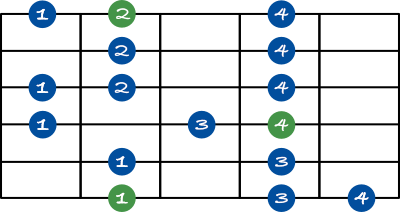
Shape 3
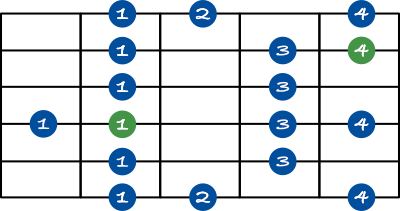
Shape 4
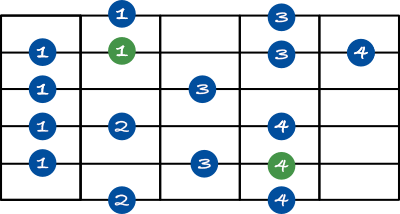
Shape 5
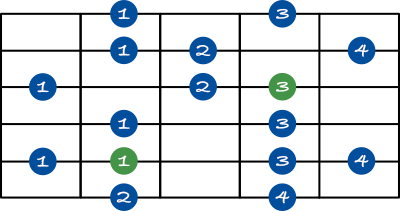
One thing to note about using these shapes is that whenever you have scales that use notes with open strings, you have to rearrange your fingers to play the shape. For example, if the shape uses the fingering 1, 3, and 4 on one string, you can play (open string), 1, and 3 instead.
Although you will need to change some fingerings if you include open strings, once you move over to the next shape where you’re fretting all the notes, you will get back to the original shapes we covered.
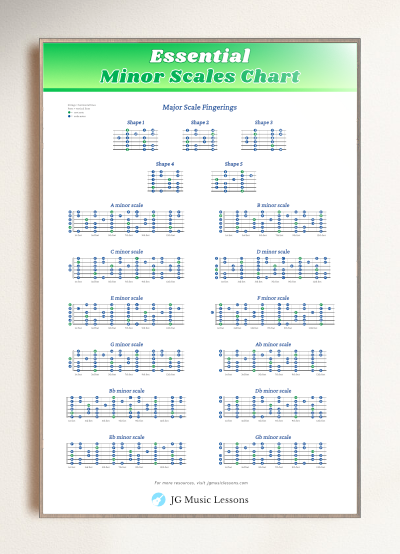
Melodic minor scale patterns
A way to practice melodic minor scales is to learn scale patterns for creative application in your playing.
The following scale patterns are just some examples you can use over a chord or chord progression. Use these examples as a guide to creating your own scale patterns. I also recommend trying these patterns in different keys to truly master them on the guitar.
The following patterns are all based on the C melodic minor scale.
4 note ascending scale pattern
The following pattern ascends four consecutive notes in the scale and repeats on the next scale degree.
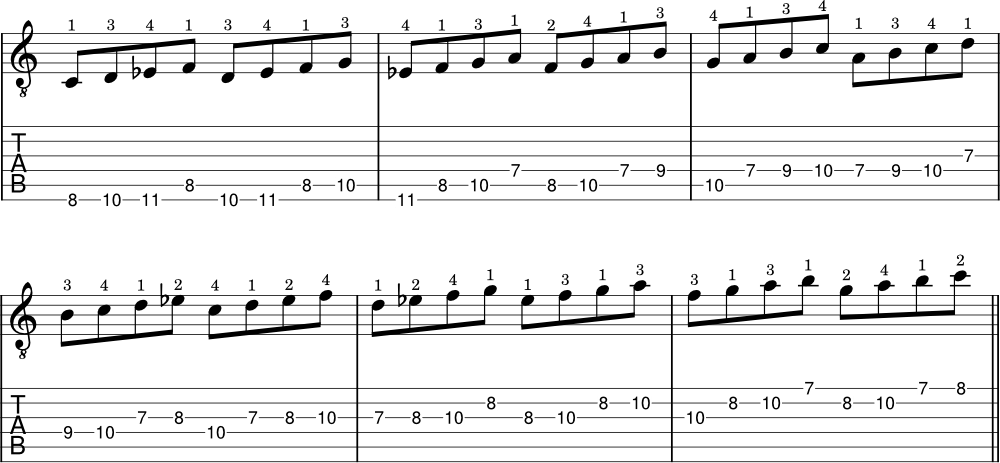
4 note descending scale pattern
This is the same 4 note concept as the previous example except we are descending the melodic minor scale.

Ascending 3rds scale pattern
For this scale pattern, we are playing intervals of thirds on each degree of the scale. You can think of thirds as skipping the next note of a scale.

Descending 3rds scale pattern
This is the same concept as before except we are descending in thirds using the C melodic minor scale.

This other guide on how to practice scales covers more application examples such playing consecutive intervals, skipping by different intervals, and using triads or 7th chord arpeggios. You may also want to learn how make your melody lines sound jazzy.
3 tips for memorizing the melodic minor scale shapes
Here are 3 quick tips to help you memorize the melodic minor scale shapes.
1. Master one shape at a time
The way I recommend learning and memorizing any scale is to start with one shape that feels most comfortable for you. Try to really get the shape under your fingers to the point where you don’t have to look at the chart. Use the first shape you master as a guide to learn the other scale shapes around it.
2. Make one note adjustments if your know the Major scale
I usually recommend looking for patterns such as what strings repeat the a fingering but it is tricker with this scale. In this case, I would suggest that if you already know the Major scale, you only have to lower the 3rd degree because all the other notes are the same.
Also, it may seem obvious but the notes on the first and sixth string will always be the same if you’re trying memorize the shape.
3. Learn to connect the scale shapes
After getting one of the shapes down really well, either learn the shape that comes before or after it to see how the scale connects on the fretboard. Again, try to master one shape at a time and make sure you can play it without looking at the chart.
This will make the process more approachable by breaking it down into smaller sections before moving on to the next shape.
Wrapping up
To get the notes of a melodic minor scale in any key, you only have to flatten the 3rd of any Major scale. Although it is simply a one note change, it takes time to get the shapes under your fingers and get the distinct sound of the scale in your hearing.
If you are interested in learning jazz guitar, the melodic minor scale is an essential scale to learn for improvisation. Once you have a good grasp of the scale shapes on the fretboard, try creating melodies and experimenting with the patterns we covered here to get more flexible using this scale.
Also, once you learn the melodic minor scale, it will be easy to learn the altered scale because it is directly related.
You may also want to learn other scales such as the harmonic minor scale, blues scale, or pentatonic scale.
📘 Get the free guitar practice guide here!
All the best,
JG Music Lessons
Start Playing Better, Faster
with Pro Membership! ✨
Get the guidance, tools, and support that keep your progress on track:
🏁 Always know what to practice next. Access the full Guitar Learning Roadmap with lessons in sequence.
🎼 Play songs with confidence. Step-by-step lessons of popular, classical pieces and other styles.
📙 Save time and frustration. Clear PDFs and ebooks that save time so you can focus on playing.
🎟️ Get rewarded for consistency. 2 free downloads every month (a $240+ yearly value).
🎁 Keep costs low while you grow. 50% off all charts, tracks, and posters — up to 75% off bundles.
🚫 Stay focused. Ad-free environment keeps you in the zone.
💬 Get help when you need it. Direct member support to keep you on track.

